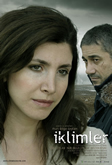|
Snow better blues
Ali Jafaar, Sight & Sound, Volume 17, Issue 2, Feb 2007
The only worthwhile subject for a film is perhaps melancholy, the director tells Ali Jaafar
Ali Jaafar: 'Climates' is about a photographer who can't finish his thesis. Your films seem often to return to the theme of the artist's blocked creativity.
Nuri Bilge Ceylan: The creative process is what demands the most from you, and it's very easy to put it to one side and do other things. Yet I know that I have to write a script, to work on it even if it's easier just to surf the internet. Isa's lack of application shows that he doesn't believe in what he does.
How much of yourself is in 'Climates'?
As with all my films, a lot. There are aspects of Isa in me, but maybe I don't show all of them.
The film starts in sun and ends in snow. You seem to like to leave your characters in the snow...
You feel the silence much better in the snow; the sound of silence.
And it shows both modern and old Turkey.
Actually, I softened that contrast. If you are preoccupied with your inner feelings then you don't notice much beyond them and everywhere looks the same. So I didn't want to show the audience that eastern Turkey is poor and I included just one character from the area, the taxi driver, whom I used to contrast with Isa.
I set this final part of the film in the east because it's a remote part of the country. When Isa learns that Bahar is there, he feels he cannot reach her easily, and it makes him respect her. She has left everything behind her to go there, which is something he could never do. Another reason for choosing the area is that the eastern part of Turkey is usually snowy, though unfortunately when we got there it was sunny all the time so we kept having to drive off in search of snow. We ended up shooting in so many different places.
Can you talk about your shooting process.
When I'm preparing the film my screenplay is very loose. I write everything down just to feel safe, but in the shooting I change a lot. Since 1 have a small crew, I have freedom and time to do so. Most of the ideas are found during the shooting, like eating the nuts at the end of the sex scene or the scene where the fly arrives on Bahar's head. You cannot direct a fly.
The sex scene between Isa and Serap is an explosion of emotion: both violence and comedy.
I didn't think it would be humorous, hut I did want to introduce the sense of there always being a fight between people. All kinds of feelings co-exist in us, and the line between the extremes is often very fragile. In real life 1 often feel like that. You have no intention to have sex, for instance, but you find yourself in a situation you never expected. Similarly, everyone has violence inside them: I believe that everyone could kill in a given situation. So I try to balance these emotions in my films rather than saying that a person is like this and so must behave in a certain way. I don't like that way of thinking.
Your characters smoke endlessly.
People smoke more when they feel weak. When you sit with other people eating, for instance, you feel nervous and you have to put on an act -like now, which is why I'm smoking a lot with you. I put in the smoking to reveal different emotions: for instance when Rahar is sleeping and Isa feels depressed because he promised her so many things and he can't deliver them, smoking helps to show how he feels.
How do you construct the sound?
Every minor detail is created afterwards. You cannot create reality with real sound. The human ear is quite selective: when we talk we don't hear the waves. So I put in the sounds that should be heard.
In the scene with the fly, for instance, I added fly sounds to the soundtrack. The buzz of the fly creates an atmosphere of boredom, which I like, and then I wanted to mix the music with the fly because the film for me should be like music, where you can stray from the subject matter just for the harmony, like composers do.
What influences the composition of each frame?
I work instinctively, deciding how to film a scene when I go to the shoot, never before. I walk around the subject and the characters for a long time to determine the placing of the camera. I like it to be still: I don't use tracks and though we had a steadicam I threw all those shots away in the editing.
Static shots excite me and they're always in my films because I feel a disconnection from reality. People are lonely in life, and in relationships between men and women you feel this even more. This is the most tragic aspect of life, this melancholy: nothing else seems to be worth making a film about. In this way I can maybe cure myself and try to connect to life. Or maybe it becomes even worse.
|

